Greenwood’s Beekeeping Journey So Far
A look back at our first season of apiculture, and the plans for the year ahead.
The benefits of bees
Of all the insects that dwell within our natural habitats and green spaces, perhaps none are quite as effective, and as vital to maintaining the environment in which they live than bees. Around 30% of our domestic crops require pollination by insects in order to reproduce and thrive, and there are roughly 70 different species of bee in the UK alone that carry out the vast proportion of this pollination.
Not only that, but they’re also responsible for the pollination of a vast array of different trees and flowering plants, which helps our green landscapes to flourish and provide habitats for many different forms of wildlife. They’re an imperative component of our ecosystems, and without them, the natural environment around us would no longer be able to thrive, and thousands of different species of plants and animals would no longer be able to survive.

Bees under threat
Sadly, our bee population is in danger. Around 35 different species of bee domestically are currently under direct threat of extinction, with all species in a considerable amount of danger. There are a number of different factors that are causing this serious decline in our bees.
Pesticides, including neonicotinoids that are used in farming, pose significant threats to wild bees. These chemicals are effective at protecting crops from unwanted pests, but they also have a devastating impact on bees, due to their widespread application and toxicity levels. The pesticides cause serious damage to the bees’ central nervous systems, greatly affecting their ability to carry out important tasks, like feeding, homing, foraging, and reproducing.
Devastating habitat loss has also been an important factor in declining bee populations. Since the 1930s, we’ve seen a 97% reduction in our wildflower meadows, which serve as a natural habitat to bees. This isn’t caused by urban development as you might expect though, it’s actually mainly through changing land use in our rural areas, for applications such as intensive farming, and the growing of crops not naturally suitable for bee pollination and habitation.
The other main factor affecting bees is climate change, and the rising global temperatures that have caused significant harm to many species. The changing seasonal temperatures are disrupting their natural cycle, altering their behaviour in the winter months, as it is becoming increasingly warmer. Not only this, but the plants and trees they rely on are beginning to blossom at different times of year, changing the annual period in which they’re ready for pollinating, so that it is no longer compatible with the bee’s natural cycle. These factors, among others, are having a devastating effect on one of nature’s most useful insects, and if we don’t act soon, we’ll be facing the consequences of losing our most important pollinators for decades to come.
As part of Greenwood’s continued commitment to sustainability and environmental responsibility, we have set out on our own beekeeping journey. We want to help encourage bee populations in our local area, and do our part in protecting the many species of bees that inhabit our green spaces. In March 2023, Greenwood were delighted to introduce two initial hives onto our Fresh Acres nursery site. A few months later, we collected our first harvest of honey. The Greenwood beekeeping initiative is blossoming!
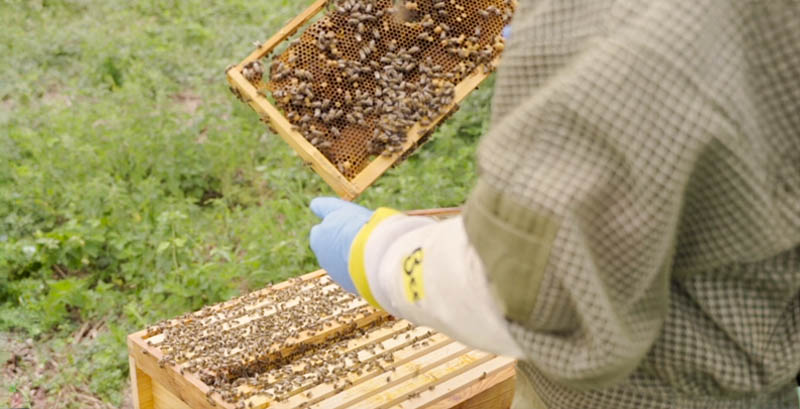
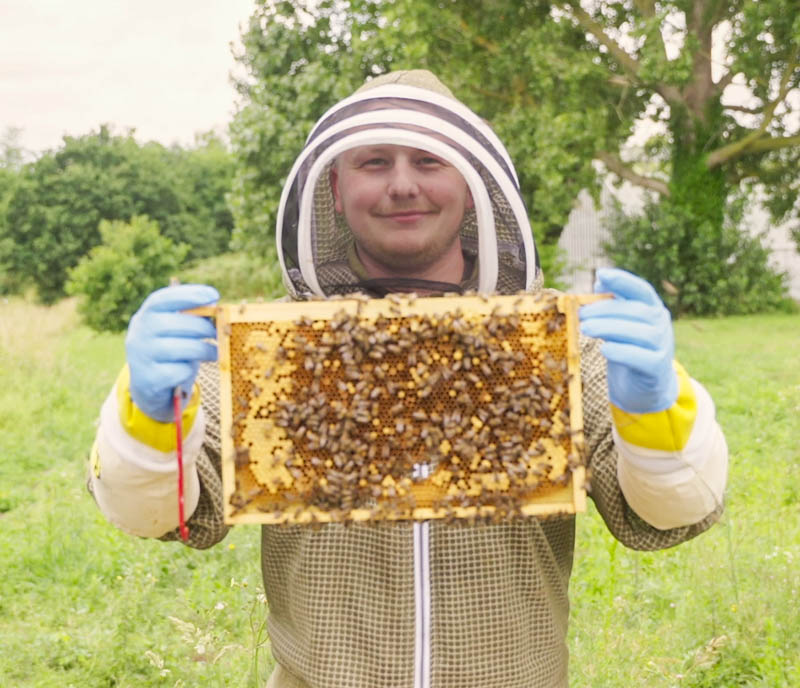
How did it all begin?
The initial idea to house bees on our nursery came from our CEO, Glenn Devenish. Bees have been in his family for a few generations, and, privy to their benefits for the environment and for pollination, when the opportunity presented itself for us to house our own hives on site, Glenn invited the G Team to get involved!
In order to care for the bees, and carry out the regular tasks that go into maintaining bee hives, we were lucky enough to have three volunteers from our passionate and enthusiastic G Team. Kevin Merritt, our Greenwood Choice manager, as well as Jacob Grace from our client service team and business development manager, Wesley Elkins, all were keen to undergo the training, trials and tribulations that are involved in beekeeping.

“It sounded interesting and I wanted to give it a go. The company covered all the costs, so I had nothing to lose!”
Jacob Grace

“I haven’t had any involvement with beekeeping since I was around 11 years old when the school I was at had hives. I think I went a couple of times and must have changed my mind as it looked hard work or maybe I got stung! I saw this as an opportunity to try again as it still intrigued me as to how bees produced so much honey from purely feeding on flowers. It would be a great hobby for me to continue after retirement.”
Kevin Merritt
The trio underwent their eight week training with the Worthing Beekeeping Association. The course consisted mostly of evening sessions, with one practical workshop at their own apiary, allowing them to get some valuable hands-on experience.
Initially, two hives were installed in a space on our Fresh Acres nursery site, these coming from a retiring member of the beekeeping association. They were purchased in addition to two colonies and various types of beekeeping equipment. For the installation, an area of ground was cleared of grass and weeds, and the hives were placed on stands, facing south as is preferred. In order to move the bees, it was vital to wait until the late evening, to ensure that all of the bees were back in the hive, and could be transported at once. In order to keep the bees in during transport, the hive entrances were stuffed with grass, and covered with tape. The tape was then removed at Fresh Acres and the following morning the bees gradually removed the grass to emerge in their new home.
The first bees that fly out at the new site recognise a different location and carry out orientation flights, circular in their nature, and gradually increasingly widening, in order to get their bearings. After a few days, once the bees become familiar with their new surroundings, they are able to forage up to a few miles away and still navigate their way back to the hive. Incredibly, bees are able to pass on navigation information and locations of food sources to other bees from the hive, by performing a ’waggle dance’. This dance involves a series of moves indicating the direction and distance of a particular location from the hive.
Fun fact:
Bees are able to pass on navigation information to other bees from the hive, by performing a ’waggle dance’. This dance involves a series of moves indicating the direction and distance of a particular location from the hive
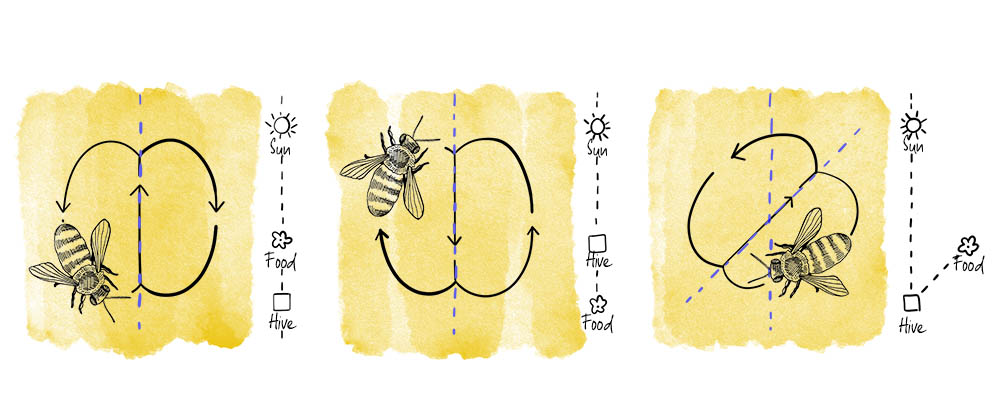

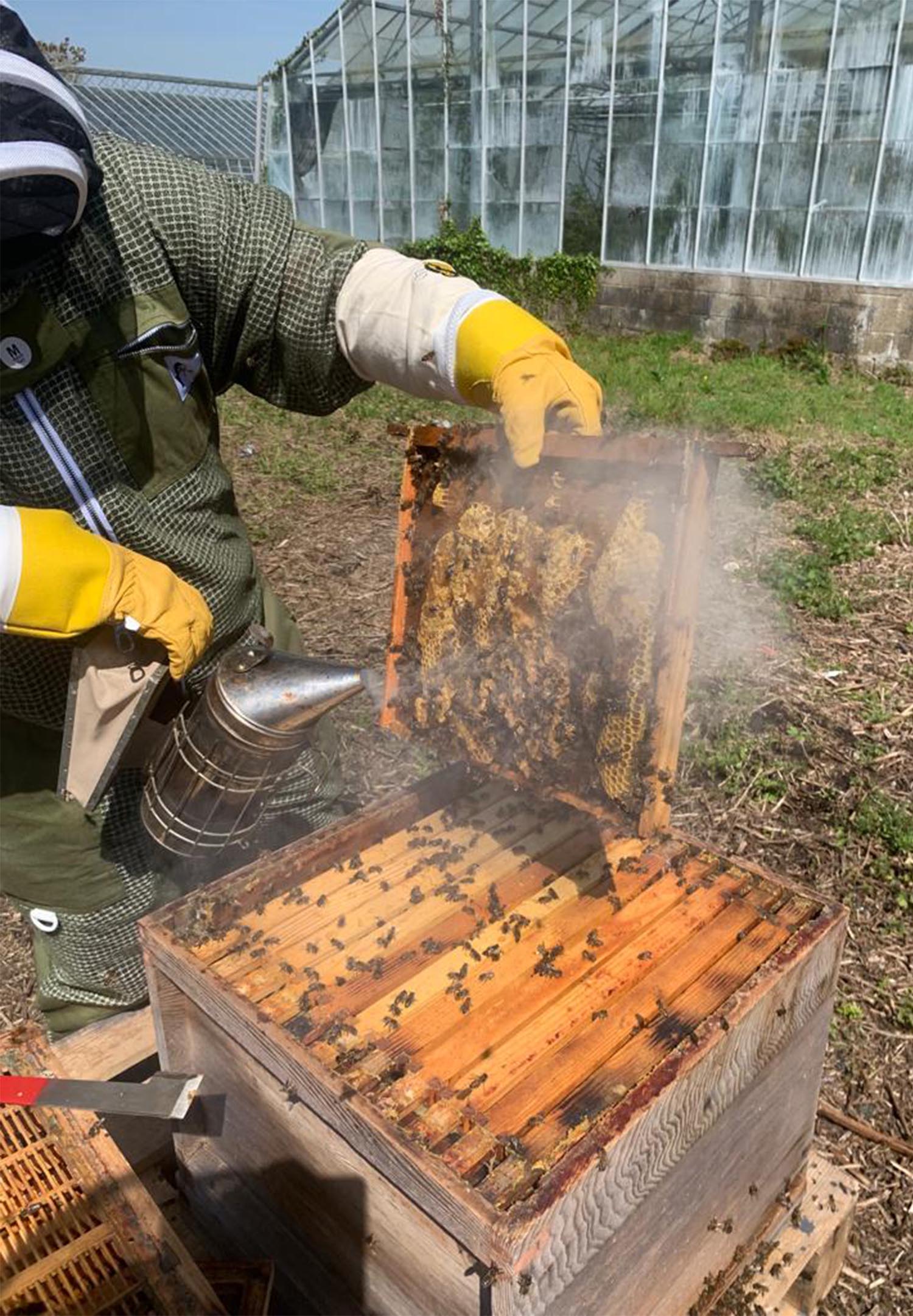
The seasonal cycle of beekeeping
During the winter months, the hives remain relatively inactive, and there isn’t too much for our beekeepers to do. It’s important to ensure that the overwintering bees have enough food to see them through to spring. Their supplies can be topped up with sugar syrup, or fondant, if their honey reserve gets too low. During these winter months, it’s also important to monitor the hives for dead bees, and check they are weatherproof, to ensure the bees are safe inside as they brave the colder months. Winter sees less hive activity so it’s the best time to look at the equipment-cleaning, sterilising, repairing and replacing any poor condition frames or parts of the hives, assuming the bees are safe and have food. Good bee husbandry must be practiced to keep them healthy and producing honey – they must be kept safe, free of disease, fed and housed in clean homes in the same way farmers look after all other types of livestock.
During Spring, as the weather begins to warm up, there is much more activity within the hive. The queen starts to lay eggs, and the population of the colony starts to rapidly increase. At this point, the floor of the hive is sterilised or replaced by the beekeepers, as well as any additional feeding if required, to keep the bees nourished until they begin producing honey again. May and June sees an even bigger increase in the population growth rate, and during this period, the need for additional feeding is reduced, as the bees begin to find their own source of food, and produce their own honey. At this point, you can add more boxes and frames to the hives, in order to give the bees more space to fill with pollen and nectar. You must be careful with the increasing populations, and watch for signs of swarming, which is when bees start looking for other places to live as they feel they need more space. A normal sized hive can go from a few thousand bees in winter to 50,000+ in summer!
Summer is the time when you can begin to harvest the hives for honey. As well as ensuring that there’s enough space in the hive for the bees to move and store nectar, this is the point where you can extract the excess honey from the hives. Provided it’s done responsibly, and you leave the bees with enough food for the winter months, this process is completely harmless to the bees. The summer is not without its dangers however, as the warmer months mean that the conditions are also ideal for pests and diseases, which are an inherent danger to the bees. One of the constant pests that poses a threat to the wellbeing of the bees is called Varroa destructor. These are parasitic mites that attack and feed on honey bees in particular. Summer is the best season in which to combat these pests, as it keeps them at bay through autumn and winter, when the bee numbers begin to dwindle. The varroacide treatment is often applied after the honey is harvested, so there’s no residual treatment in the honey itself.
Regular inspections during the season require the beekeepers to check for signs of any issues within the hives, including diseases, bugs, as well as the size and number of the bees. These regular checks ensure that the team are well on top of any issues that may arise.
As the summer fades into autumn and the temperature begins to drop again, it’s time to prepare the bees once again for the winter season. Mouse guards must be fitted before winter, as the mice will otherwise invade the hives once the plentiful food of the summer months dries up, looking for the sweet delights the bees have worked all summer to produce. Lastly, during October to December, the hives must once again be checked to ensure they’re weatherproof, and safe from the elements. This also is the time to top up their food supplies with sugar syrup and fondant before the winter period, where the cycle starts all over again.
Harvesting honey
Whilst the most important benefits to keeping bees are routed in biodiversity and environmental factors, one of the nice bonuses of keeping bees is the ability to harvest the excess honey in the hives. The bees at Greenwood produced their first harvest of honey of the summer, a jar of which was kindly given to each member of the G Team.
In order to harvest the honey, a number of the frames from the supers (which are boxes at the top of the hive above where the queen bee lays the eggs) are removed, once they are full of capped cells of honey. Throughout the year, bees fill these cells with nectar and then ‘cap’ the tops, sealing them off as storage for food to eat later in the year. As long as you leave some of these capped cells for the bees going into autumn and winter, you can take some of these frames out to extract honey.

The capping is scraped off the top, and the frames are put into a centrifugal extractor. The frames are then spun around, which causes the honey to pour out and collect in the bottom of the stainless steel extractor. A tap at the bottom of the extractor enables the honey to drain out, through a double filter into a storage tank. The filters are necessary to remove small amounts of wax and capping that will come out of the frames. After this process, the honey is then left to settle for a short period of time, before it is then be poured into jars, ready for eating.
The amount of honey that can be produced by a hive varies a lot depending on conditions, location, and the food sources available to the bees. A standard hive can produce anything from 20 lbs (10kg) to 60 lbs (25 kg) of honey. As this was the first time our new beekeepers have harvested honey, there were a few lessons learned, that will be useful moving forward to next season’s harvest. For example, this year the beekeepers harvested over two days, which ended up creating more of a cleanup job over the two days, and produced more wastage than the beekeepers would have liked. For the next harvest, they plan to harvest during one day, to help reduce the wastage, and the amount of cleanup required. Despite this, from two hives they were able to achieve a yield of 70 lbs (32kg) of honey, which is a great result from a first harvest!
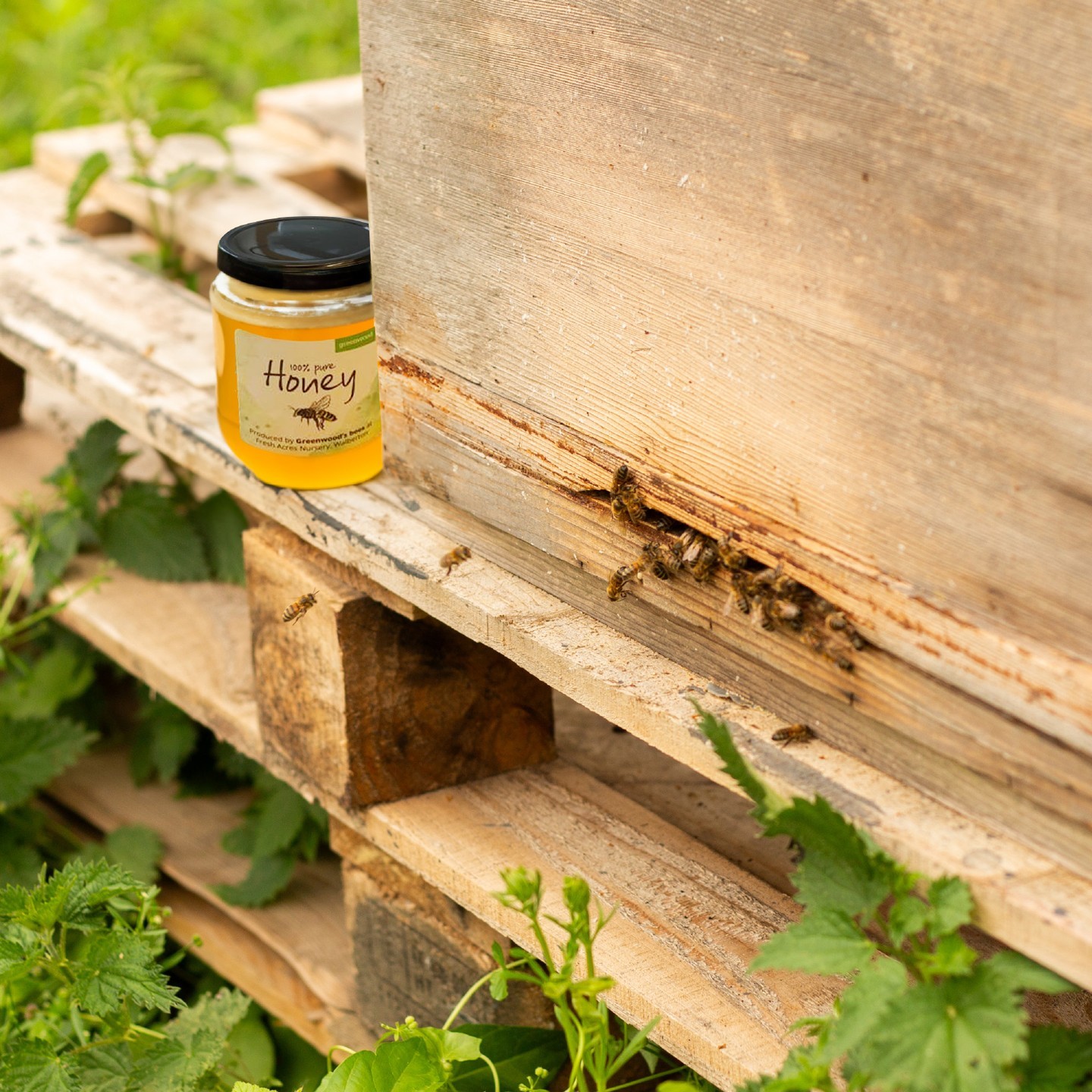
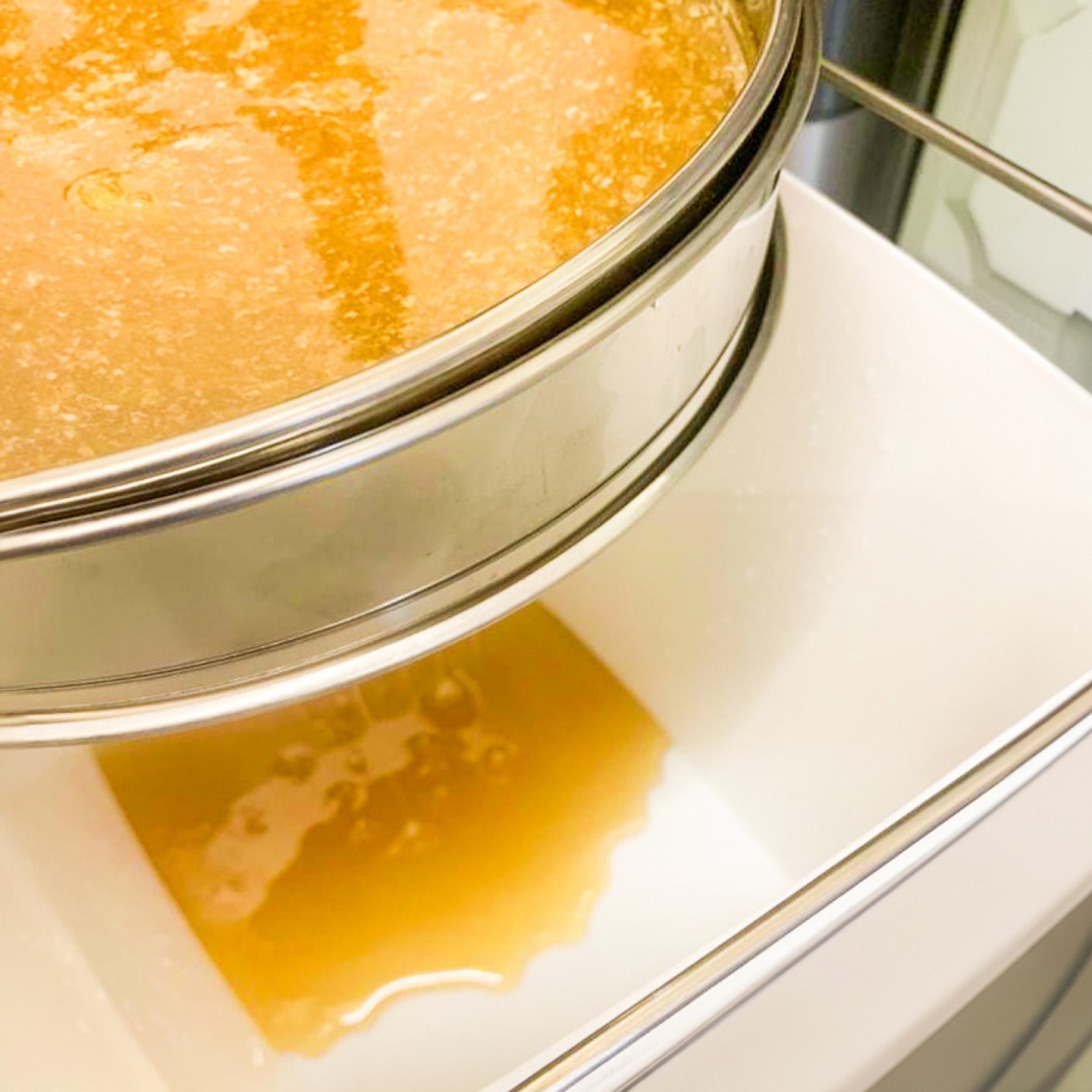
Challenges to overcome
Whilst overall, the beekeepers are pleased with the outcome of their first few seasons, it wasn’t without its challenges and obstacles. As first year beekeepers, it’s important to acknowledge that, whilst there’s been a lot that’s gone right, inevitably there have been some challenges which have been part of the learning process, as well as a lot of stings!
There have been losses, including swarms where queens have left hives and moved on, resulting in the overall loss of the hive. There have also been slight issues or errors, such as carrying out tasks too early, or too late. Thankfully, the beekeeping association with which the training was undertaken are on hand as mentors, to guide our new beekeepers as they learn and develop. Much like plants, bees are living organisms, meaning that the variable factors that determine success are huge, and not all within our control. Building on their experience, learning valuable lessons, and continuing to seek advice from experts will mean our beekeepers will increase their knowledge and skills, and enable them to flourish.
Regular inspections during the season require the beekeepers to check for signs of any issues within the hives, including diseases, bugs, as well as the size and number of the bees. These regular checks ensure that the team are well on top of any issues that may arise.
As the summer fades into autumn and the temperature begins to drop again, it’s time to prepare the bees once again for the winter season. Mouse guards must be fitted before winter, as the mice will otherwise invade the hives once the plentiful food of the summer months dries up, looking for the sweet delights the bees have worked all summer to produce. Lastly, during October to December, the hives must once again be checked to ensure they’re weatherproof, and safe from the elements. This also is the time to top up their food supplies with sugar syrup and fondant before the winter period, where the cycle starts all over again.
Greenwood plans for future
Moving forward, the plan is to expand into more hives, and set up hives on more of our nurseries. The bees will be moving in the winter to a new, permanent location, where the hives will be split in the spring to hopefully increase our total to four hives. The next big challenge for the team will be to get the hives through their first winter. It’s not easy, and the cold weather certainly makes it difficult for the bees to survive. Providing that our beekeepers can successfully navigate this first winter season, they’ll be ready for expansion in the spring.
It is important however, before expanding too much, to ensure that we have enough volunteers willing to undertake the training and assist the team with the regular duties. Once we’re ready, we hope to train up even more volunteers to begin their beekeeping journey, and help Greenwood continue to care for the expanding population of bees, and allow the surrounding natural habitats to reap the benefits that our buzzing colleagues can bring.
Overall, our beekeepers have very much enjoyed their first experiences in the job, and despite the occasional stings, and the various challenges, they’re relishing the growth and development that their new beekeeping role is giving them.

“There is so much more to bees and beekeeping than I could have ever imagined. It has been great seeing how bees operate in a hive, and to be able to produce so much great tasting honey after watching them come and go from the hive bringing back pollen and nectar, was a really satisfying experience.”
Kevin Merritt
Be sure to follow us on our socials for more regular updates from our beekeepers and our hives. If you’d like to learn more about our other various sustainable practices, you can do so via our sustainability page.

